08 – 24 FEBRUARY 2023
By Eduardo Ormaeche
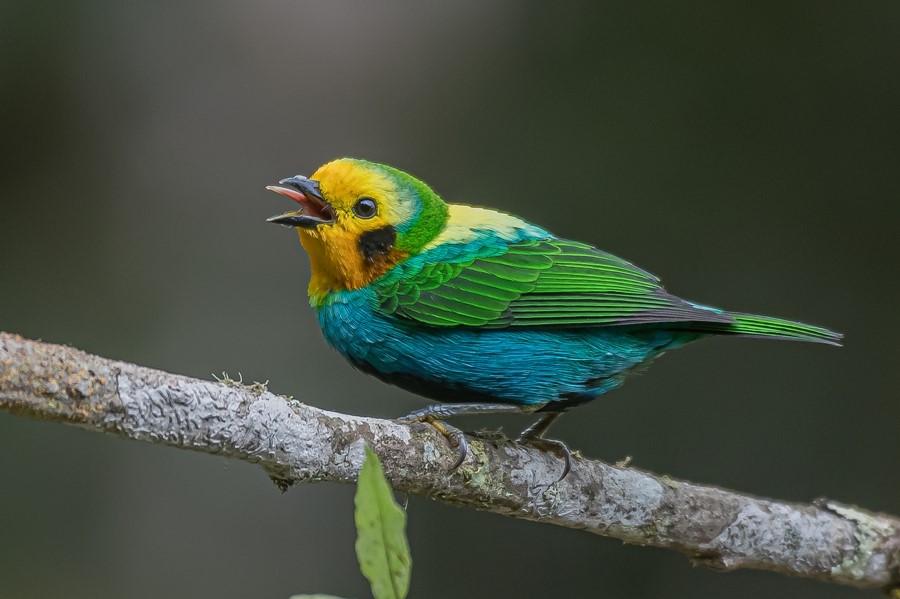
The endemic Multicolored Tanager is one of the most spectacular tanagers in the world (photo Alejandro Grajales).
Overview
After some years of waiting, I had the privilege of returning to Colombia to lead this tour, which we had planned before the COVID pandemic hit. This was a special tour offering our clients and friends an opportunity to see different parts of Colombia compared to the traditional birding routes. We decided to be adventurous and explore the possibility of a birding route through the southern Andes, from Cali, across the Paramo de Bordoncillo, and the Trampolin Road to the Amazonian foothills around the Putumayo River. In addition to this, a second leg focused on the eastern region of Casanare, in the Colombian Llanos. We called this tour Colombia Uncovered. I was delighted to return to this incredible country after stopping guiding here in favor of my very good friend and colleague, Giancarlo Ventolini. I had also been very busy giving other South American countries my personal attention, but this was a new tour we were developing, and what better opportunity to visit this amazing country again.
Planning and preparations had proceeded well and were at an advanced stage, with the Birding Ecotours team and our excellent ground partners finalizing all minor details to start the trip. Unexpectedly, on January 10, 2023 – less than two months before the start of the tour – a colossal landslide destroyed an important section of the Pan-American Highway and adjacent villages, with 64 houses destroyed and 700 people displaced. The part of the highway that was destroyed formed part of our planned route, from Popayán to Mocoa. Alternative driving routes near the main highway were not a viable option, as they would be heavily congested with traffic. After studying various possible options, we decided to travel by vehicle from Popayán through Purace National Park, to Pitalito, and the across Huila State to Mocoa. This route had incredible birding opportunities, but unfortunately missed Paramo de Bordoncillo and Trampolin, which meant no chances for Chestnut-bellied Cotinga and White-rimmed Brushfinch. At the end of the trip, I felt a great personal satisfaction when the participants agreed that they had thoroughly enjoyed the modified tour and thought that it worked better than the originally planned tour. They asked me if we would advertise this tour, rather than the original plan, just to point out how much they enjoyed it.
Needless to say, this trip provided some of the classic, most-wanted and iconic birds of the neotropics, as well as a nice set of endemics and range-restricted specials, including Andean Condor, Andean Cock-of-the Rock, Torrent Duck, Sword-billed Hummingbird, Grey-breasted Mountain Toucan, Orinoco Goose, Jabiru, Roseate Spoonbill, Horned Screamer, Band-bellied Owl, Tolima Blossomcrown, Tolima Dove, Hooded and White-bellied Antpittas, Amazonian Umbrellabird, Golden-winged Tody-Flycatcher, Lemon-throated Barbet, Sapphire-rumped Parrotlet, Long-billed Woodcreeper, Rufous-headed Woodpecker, Coopery-chested and Pale-headed Jacamars, White-bearded Flycatcher, Sharp-tailed Ibis, Hoatzin, Sunbittern, Bicolored Hawk and Crestless Curassow. Endless numbers of Scarlet Ibises roosting before sunset in the ponds of water in Los Llanos was a magical experience. Wildlife was not ignored on this trip – our first Colombia tour with a significant amount of wildlife – including, unexpectedly, Amazon (Pink) River Dolphins only a few meters from the boat, Giant Anteater, Southern Tamandua, the endemic Colombian Black-handed (Medem’s) Titi, Humboldt Squirrel Monkey, Red (-crowned) Titi Monkey, Orinoco Crocodile, Capybaras, and the impressive Green Anaconda.
Detailed Report
Day 1, 08th February 2023. Arrival in Cali
Today was our arrival day in Cali and we made our way to the hotel and discussed the exciting trip ahead.
Day 2, 09th February 2023. Finca La Florida
All tour participants had met the previous night in the city of Cali. The first day of the tour was a predawn start from Cali to drive to the famous Km 18 and visit Finca La Florida. This relatively new private reserve and feeding station has become very popular among birders and photographers in Colombia, providing a great selection of birds, including two endemic stars, Multicolored Tanager and Chestnut Wood Quail. As soon we arrived at the property, we were received by Andean Motmot and then amazed by the number of birds coming to the feeders, including handsome and colorful species such as Red-headed Barbet, and Golden, Saffron-crowned, Golden-naped, Palm, Blue-grey, White-lined, and Black-capped Tanagers which were all seen nicely. In addition, the endemic Flame-rumped Tanager and striking Multicolored Tanager gave us repeat views, to the full satisfaction of our group. The hummingbird feeders attracted beautiful avian jewels such as White-booted Racket-tail, Western Emerald, Steely-vented and Rufous-tailed Hummingbirds, Fawn-breasted Brilliant, Long-tailed Sylph, White-necked Jacobin, Brown Violetear and Tawny-bellied Hermit. After our breakfast and heavenly Colombian coffee (and equally good chocolate, for some) we went directly to the quail feeders to feast our eyes on excellent views of a family party of Chestnut Wood Quails. The lighting and distance were perfect, allowing us to study every minute detail of these great birds.
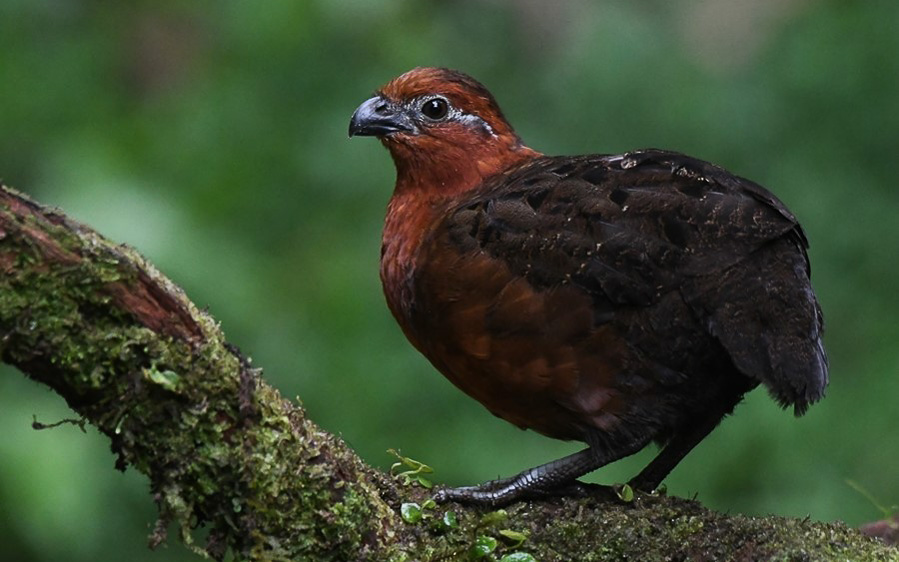
The endemic Chestnut Wood Quail was seen well at La Florida (photo Alejandro Grajales).
We also used the opportunity to walk some of the trails on the property, following the call of a Narino Tapaculo, but it remained heard only. We were still glad, though, because the elusive Chestnut-breasted Wren soon showed for us, but sadly covered by some leaves, and not everyone managed to get this skulking species. We were also rewarded with an unexpected Golden-winged Manakin (male) which was seen by the whole group. Property staff pointed out a Common Potoo at its daytime roost, which was a nice surprise and a highlight of the first day, especially for those who were setting foot in the neotropics for the first time. Other birds in the area included sightings of Sickle-winged Guan, Acorn Woodpecker, Montane Woodcreeper, Scarlet-fronted Parakeet, Black-billed Thrush, Great Kiskadee, Tropical Kingbird, Brown-capped Vireo, Rufous-collared Sparrow, Eared Dove, Shiny Cowbird, Saffron Finch, Canada and Blackburnian Warblers, Yellow-headed Caracara, Black Vulture, and the handsome Green Honeycreeper.
Before enjoying lunch, we heard the calls of Golden-headed Quetzal calling from the nearby forest, and with a good strategy, we managed to see a beautiful pair near the parking lot. We got scope views and the photographers amongst us tried their best to get shots of this lovely bird.
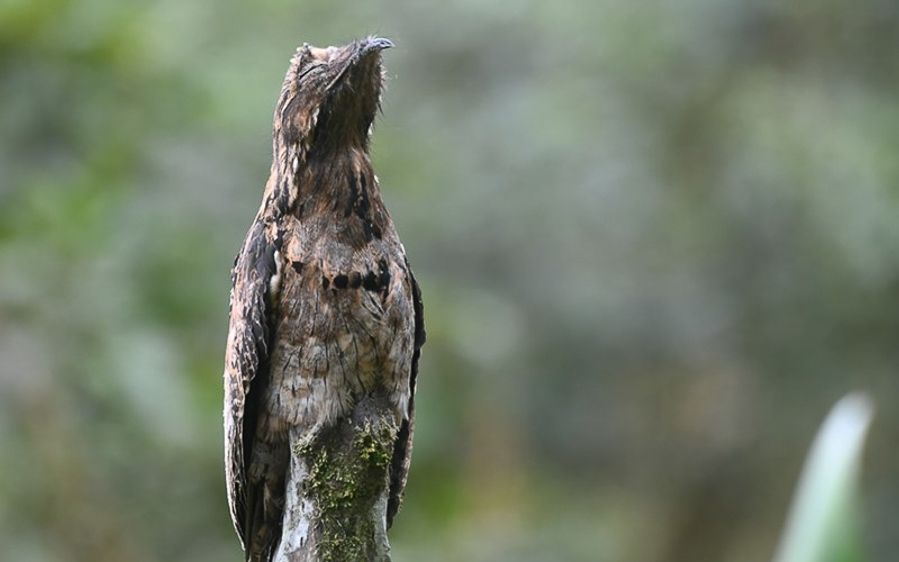
Common Potoo at its day roost at La Florida (photo Alejandro Grajales).
After a delicious lunch at La Florida we started the 100-mile (160-kilometre) drive from La Florida to the southern city of Popayan, arriving late in the afternoon.
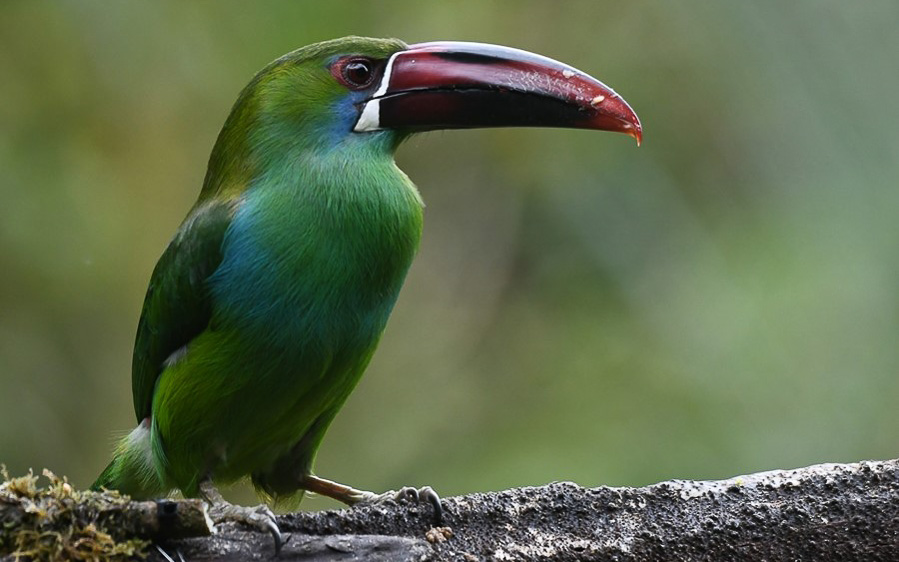
Crimson-rumped Toucanet (photo Alejandro Grajales).
Day 3, 10th February 2023. La Piedra del Cóndor and Puracé National Natural Park
We left Popayan and headed towards Puracé to visit La Piedra del Cóndor, a high-elevation montane forest habitat where Andean Condor can still be seen roosting on the mountain cliffs. It is also one of the few accessible places in the country to see the near-endemic Caranculated Caracara. We were given an informative introduction to the tourist project being run by the local Andean community of Puracé. It is a commendable project, aiming to conserve the area and attract and cater for visitors in a sustainable way. We were then placed at a well-known stakeout with stunning views of the surrounding landscape, and in front of the huge rock La Piedra del Cóndor, where the locals put out meat to attract the condors. I quickly spotted the bird roosting on the cliff and we all had good views through the spotting scope. We waited patiently to see if the condor would descend from the top of the cliffs and feast on breakfast. There was not much other bird activity until we saw a Caranculated Caracara coming to the rock, providing great views. Only a few participants had seen it before, in other locations like the mountains and national parks such as Antisana, above Quito, Ecuador.
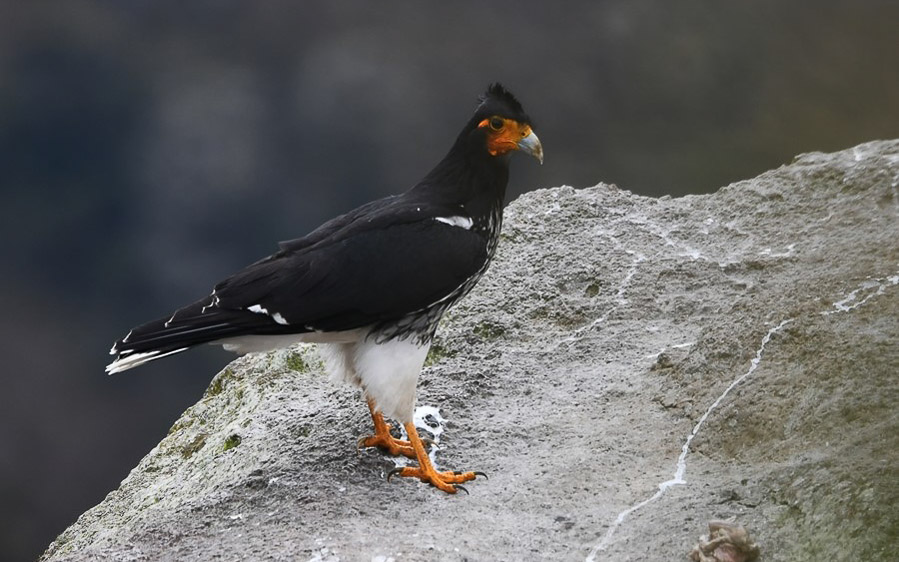
Caranculated Caracara (photo Alejandro Grajales).
After quite a long time we saw the Andean Condor descending from the top of the cliff and heading straight towards us. It maneuvered in the air, turned around, and finally perched on the rock to eat some food. It was a fantastic experience to have one of the most iconic birds in the world soaring right above us. Although people see condors in places like the Andes of Peru, Chile and Argentina, they are often only seen at a distance. It truly was awesome to see its imposing size from so close!
We had a long drive ahead of us, across Puracé National Natural Park, on our way to San Agustin. So we left La Piedra del Cóndor and decided to spend less than an hour birding along the road. During our condor watch I had heard the call of Grey-breasted Mountain Toucan, so decided to give it a chance. Fortunately, I took the group to the right spot, where a family of toucans were flying by. Even though they were a bit further from the road, there were great photographic opportunities. Everyone certainly enjoyed one of the most spectacular mountain toucans in the Andes which was a big target for some of our group. Then we drove lower and made another stop, where we got our first views of Sparkling Violetear,calling and making territorial displays from the Eucalyptus trees. Even more importantly, we were able to find a couple of White-throated Toucanets.The birds here belong to the endemic griseigularis race,found only in western and central Colombia. There is still controversy over Emerald Toucanet taxonomy, after being split into seven different species, with some considered conspecific, by other taxonomic authorities. The International Ornithological Congress (IOC) considers Aulacorhynchus albivitta as White-throated Toucanet, with four different races. The Handbook of the Birds of the World (HBW) uses the name Grey-throated Toucanet to refer to the same species, Aulacorhynchus albivitta,and eBird uses the name Southern Emerald Toucanet. I suggest keeping track of all subspecies and races because one does not know when they might be split or lumped together again.
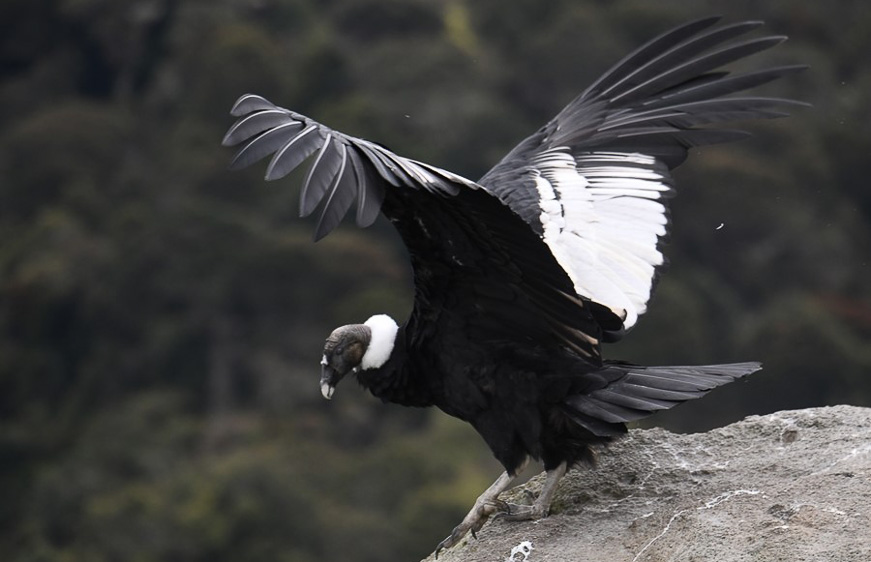
We had incredible views of this female Andean Condor (photo Alejandro Grajales).
We then continued our drive towards San Agustín, crossing Puracé National Park. The dreamers amongst us kept their eyes open for Mountain Tapir, whilst the others admired the landscape or took a short nap. We did, however, make two important stops along the way. First, we stopped to look at Frailejones, beautiful plants in the Espeletia family that dominate the páramos of Colombia. Only those who had visited Colombia before had seen these beautiful plants at the base of Nevado del Ruiz’s snow-capped volcano, which rises above the city of Manizales. This active volcano is a famous birding spot and home of the beautiful Buffy Helmetcrest. The other highlight of our long drive was seeing Hooded Mountain Tanager,which is the second-largest tanager in the world, after White-capped Tanager. With all these amazing sightings, great anticipation for the coming days, and a little fatigue after the first early starts, we arrived in San Agustín and settled into our comfortable hotel. We then enjoyed a delicious supper and a good night’s sleep.
Day 4, 11th February 2023. San Agustín Archeological Park and surrounds
After a beautiful sunrise and a tasty breakfast, we found some birds in the hotel grounds, including the first Inca Jay and Buff-rumped Warbler, which was skulking on the small forest stream banks. We then drove to San Agustín Archeological Park. This park contains one of the largest collections of religious monuments and megalithic sculptures in Latin America, and was declared a UNESCO World Heritage Site in 1995. We had great birding in the park, including our first views of the endemic Colombian Chachalaca. Their noisy calls were all around us, announcing our arrival at the park. We spent the first few hours of the morning having nice encounters with species such as Ruddy Pigeon, Squirrel Cuckoo, Andean Motmot, Smoky-brown Woodpecker, Plain Antvireo, Scale-crested Pygmy Tyrant, Great Crested and Rusty-margined Flycatchers, Grey-breasted Wood Wren, Chestnut-capped Brushfinch, Slate-throated Saltator, Blue-grey, Bay-headed, and Blue-necked Tanagers, and Rufous-collared Sparrow. We had to work harder than usual and were rewarded with great views of Western Fire-eye and Slaty Spinetail. Sadly, some birds remained heard only, including Orange-billed Nightingale-Thrush, Whiskered Wren and Streaked Xenops. We also found the migratory Canada Warbler and Swainson’s Thrush. We then had good views of Black Phoebes during our refreshments. After a few hours enjoying the birding and being introduced to the fascinating pre-Columbian civilizations, we left the park and headed for lunch at a local restaurant. After lunch we went to explore a nearby wetland which, incredibly, provided excellent (but brief) photograph opportunities of the secretive but widespread White-throated Crake.
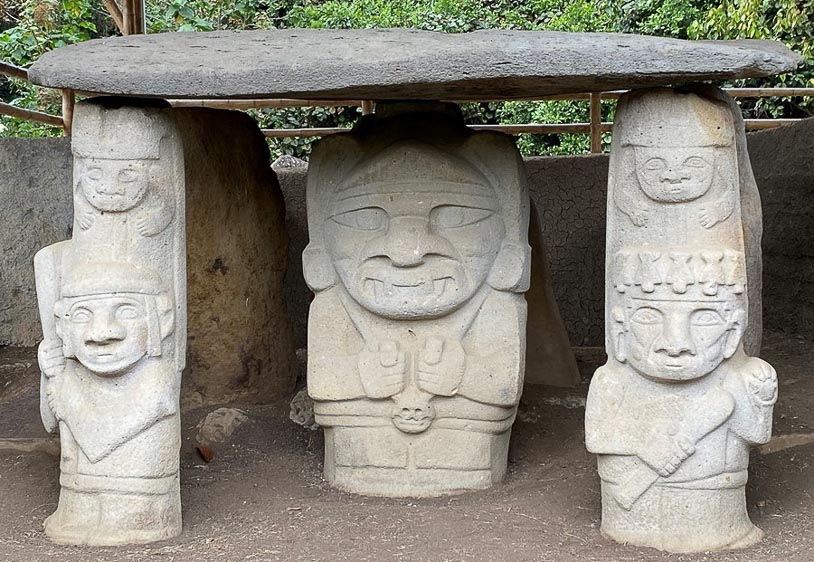
A tomb platform with supporting statues (photo Alejandro Grajales).
In the afternoon we spent the rest of the day looking for and photographing water birds and open-country species in a different wetland not far from San Agustín. We added species such as Black-bellied Whistling Duck, Blue-winged and Cinnamon Teals, Common Gallinule, and Southern Lapwing, while enjoying great scope views of a single male Masked Duck (together with two females), with Grey-cowled Wood Rail, Great, Snowy and Western Cattle Egrets, Little Blue and Striated Herons, Wattled Jacana, Solitary Sandpiper, Bare-faced Ibis, and Black-crowned Night Heron all seen in the area too. A great moment of excitement came when, while scanning the reeds with the scope, I suddenly spotted a Wilson’s Snipe right out in the open at the edge of the reeds. Everyone had good looks through the scope. Things got even better, with a Sora crossing the open spaces of the reed islands, giving everyone perfect views. We enjoyed some open-country species as well, such as Vermilion (female) and Piratic Flycatchers, and Tropical Mockingbird. We also had Southern Rough-winged Swallows and nice, but distant, views of Yellow-hooded Oriole.
After enjoying our fill of the abovementioned species, we decided to walk towards a large patch of Guadua bamboo, where we heard a lowland bamboo special, Large-headed Flatbill. Sadly, access to the interior of the patch was not easy and we were running out of time. We heard a raptor call and played Bicolored Hawk and this magnificent hawk came towards usand perched in the open, providing magnificent scope views. Generally, accipiters are difficult to see, making this sighting the cherry on top. We happily called it a day and drove to Pitalito for our two-night stay.
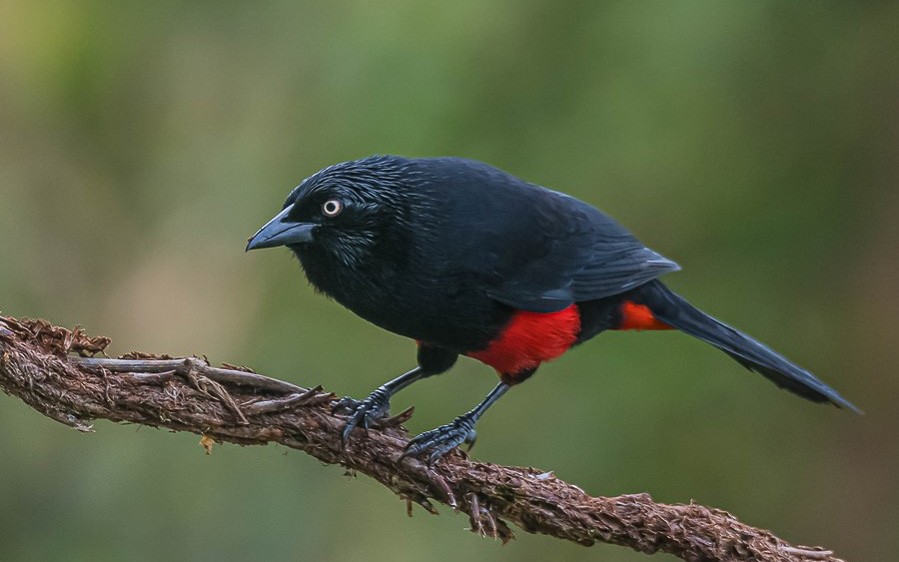
The endemic Red-bellied Grackle was seen nicely atEl Encanto Reserve (photo Alejandro Grajales).
Day 5, 12th February 2023. El Encanto and Drymophila Reserves
We had an early start and drove towards the recently established El Encanto and Drymophila Reserves, both run by a local family who have decided to invest in ecotourism and conservation. These reserves were put on birders’ radars recently (after the COVID pandemic) when the secretive Schwartz’s Antthrush started coming to the bird feeders. Sadly, it didn’t show up during our visit. Nevertheless, we got other great birds during our full-day visit. We started the day exploring the Drymophila Reserve, getting species such as Inca Jay, the endemic Red-bellied Grackle, the endemic and localized East Andean Antbird (Drymophila caudata; the reserve takes its name from this genus). The hummingbird feeders attracted interesting species, such as Andean Emerald, Crowned Woodnymph, Buff-tailed Coronet, Gorgeted Woodstar, Bronzy Inca, Lesser, Sparkling and Brown Violetears, White-booted Racket-tail,and theendemic and recently split Tolima Blossomcrown,one of the stars of the reserve.
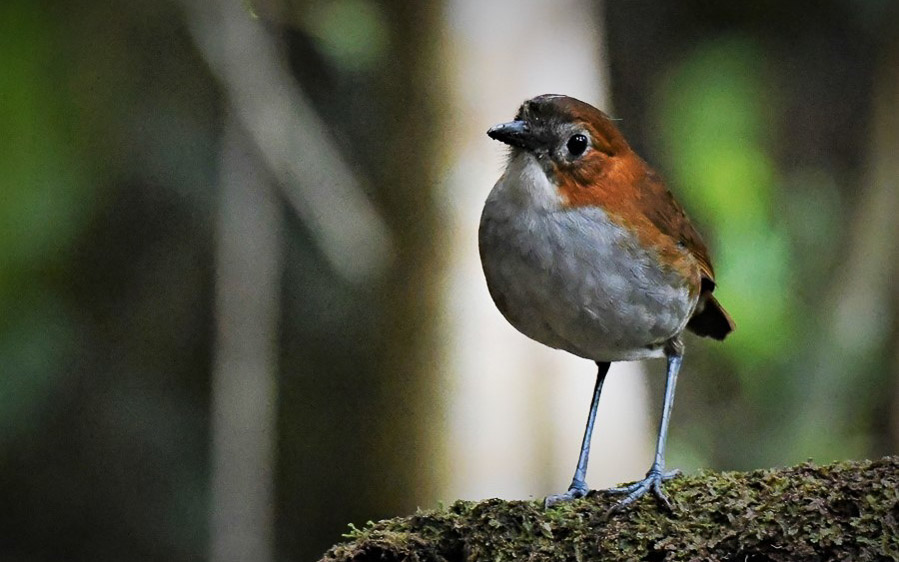
We had good views of White-bellied Antpitta at El Encanto feeders (photo Alejandro Grajales).
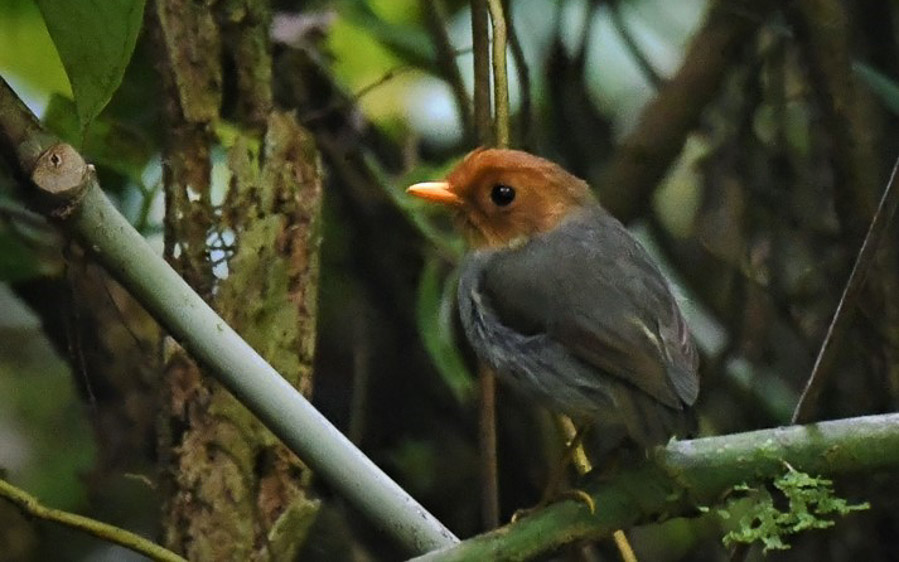
We were delighted to see the enigmatic Hooded Antpitta at El Encanto feeders (photo Alejandro Grajales).
We visited the bird feeders of the Drymophila Reserve and were rewarded with excellent views of White-bellied Antpitta, and the enigmatic Hooded Antpitta, amega-rare near-endemic. Wehave seenit regularly on our previous Colombia tours at El Cedral in the Otún Quimbaya Fauna and Flora Sanctuary, but this was the first time we had seen it attending a worm feeder. We got great views of both but, sadly, there was no hope for the Schwartz’s Antthrush, which had not been seen in a while. Other interesting species at the bird feeders were the large and secretive White-throated Quail-Dove and the endemic and localized Tolima Dove.We saw the silhouette ofa Scaly-naped Amazon flying above the reserve, but it was too far away for the group to count. We returned to El Encanto along a very rough road and some of us managed to see Yellow-faced Grassquit and Lesser Goldfinch.
We savored a delicious homemade lunch at the family house, and then continued birding around the house. We saw White-lined Tanager (male and female), a tanager that does not mix with other species in flocks. At the same fruit feeders we also saw Blue-grey, Palm, Blue-necked and Bay-headed Tanagers.We got nice views of Squirrel Cuckoo, Streaked Saltator, Red-headed Barbet, Scrub Tanager, the beautiful Crimson-backed Tanager, Thick-billed Euphonia, the endemic Velvet-fronted Euphonia, Red-crowned Woodpecker, Crimson-rumped Toucanet, Pale-breasted and Black-billed Thrushes, and the well-known Rufous-collared Sparrow.
Before we left the reserve, we managed to get good views of the endemic Apical Flycatcher, as well as Ash-browed Spinetail, and Rufous-naped Greenlet. The hummingbird feeders provided Red-billed Emerald, White-vented Plumeleteer, the endemic Indigo-capped Hummingbird, Black-throated Mango, and Rufous-tailed and Shinning-green Hummingbirds.We then returned to Pitalitoto get some rest in the late afternoon.
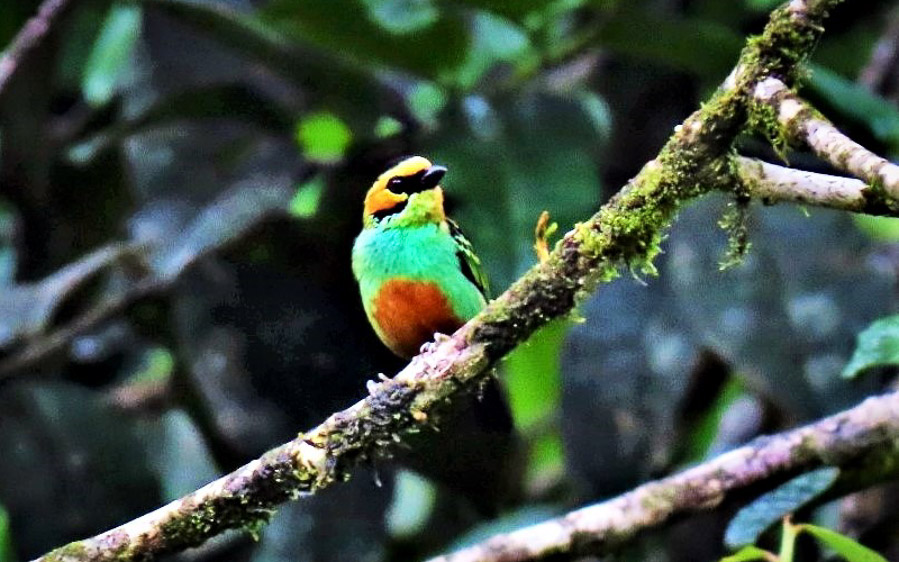
Golden-eared Tanager (photo Diego Rocha).
Day 6, 13th February 2023. Birding lowland hotspots around Mocoa
This morning we drove towards Mocoa, the capital of the Putumayo department, located at 1,980 feet (605 metres) elevation. We planned to spend the next few days focusing on lowland species that are hard to find in Colombia (but may be possible to see elsewhere in South America). These species may indeed be found around Mocoa at some of the few accessible Amazonian lowland hotspots in Colombia.
We started birding some hotspots near Mocoa, including Bosque Verdeyaco, La Ruta del Barniz, and Km. 51. Bosque Verdeyaco received us with great views of species like Speckled Chachalaca, Scaled Piculet, the striking Paradise Tanager, also Magpie, White-lined, White-shouldered, Blue-grey, Palm, and Silver-beaked Tanagers, Yellow-rumped Cacique, Crested and Russet-backed Oropendolas, Thrush-like Wren, Yellow-browed Sparrow, Violaceous Jay, Olive-sided Flycatchers, and Chestnut-collared and White-collared Swifts.
In the late morning sporadic showers became heavy rains. Unfortunately, this happened on almost all our afternoons in the Amazonian foothills, limiting the time available for birding and thus the number of lowland species recorded. Birding next to the road and checking the rivers provided views of Torrent Duck for all participants and Amazonian Umbrellabird for only some of us.
We explored another hotspot, where we had amazing views of Coppery-chested Jacamar,our first attractive jacamar for the trip. Another interesting species was the huallagae race of Yellow-whiskered Bush Tanager (considered by Cornell to be Short-billed Chlorospingus). We continued birding the Verdeyaco forest, getting some common species (but new for the trip), such as Grey-capped Flycatcher, Great Kiskadee, Lemon-browed Flycatcher, Red-capped Cardinal, Yellow-headed Caracara, and Smooth-billed Ani. We heard Dusky Spinetail,which did not want to cooperate with us, as well as Little Tinamou, calling in the distance.
In the evening we visited a spot on the outskirts of Mocoa town to look for Band-bellied Owl, which showed nicely for everyone.
Days 7-8, 14-15th February 2023. Vereda Campucana and Bosque de Verdeyaco
We spent the next couple of days exploring the Amazon rainforest foothills around Mocoa. We explored a family property where we got a nice set of birds, including the always-stunning Rufous Motmot, the uncommon Lemon-throated Barbet, Chivi Vireo, Boat-billed Flycatcher, Violaceous Jay, Cerulean Warbler, and Summer, Yellow-bellied (a glimpse for some of the group), Blue-necked, and Turquoise Tanagers. We also saw Golden-tailed Sapphire, a new hummingbird for the trip.
After a brief but productive stop on this property, we went to explore Vereda Campucana, unfortunately spoiled by lots of fine and continuous rain. A steep track passed through the forest where the mythical Black Tinamou has been seen, but the rain was not helping, especially on the upper parts of this road. As bird activity was rather quiet and the trail was slippery, we decided to retreat, but were then splendidly rewarded with the uncommon Black-streaked Puffbird.It is found in similar habitat in Peru and Ecuador, but this is the northern limit of its range in southern Colombia. We were happy for Sue, who found a female Andean Cock-of-the Rock, a bird she badly wanted to see. We managed to see Slaty-capped Flycatcher, Black Phoebe, Pale-vented Pigeon, Chestnut-eared Aracari, Swallow Tanager, Yellow-bellied Dacnis, Buff-throated Saltator, and Purple Honeycreeper. The following birds were heard only: Cinereous Tinamou (distantly), Orange-billed Sparrow (close, but no cigar), Lined Antshrike and Dusky Spinetail.
We also birded some strategic sites back along the main road, one of which gave us full views of the most-wanted and hard-to-see Golden-winged Tody-Flycatcher.That was another super moment of the trip! We added several common birds, including Southern Rough-winged and Blue-and-white Swallows, Black Vulture and Blue-headed Parrot. We returned to Bosque de Verdeyaco, where we got some new birds, such as Green-backed Trogon, Thick–billed and Orange-bellied Euphonias, Canada Warbler, Golden Tanager, Smoke-colored Pewee, and Olive-sided and Acadian Flycatchers. We had decent views of Glittering-throated Emerald and glimpses of Wire-crested Thorntail feeding on an Inga tree near the property entrance. The male was seen by a few only, while the female was seen on more than one occasion, albeit very briefly.
For these couple of days we enjoyed lunch at the hotel and then kept the afternoons free to evade the foreboding weather. Participants were glad to have an opportunity to work on their photos and enjoy some leisure time.
Day 8, 15th February 2023.El Escondite
Following our adventure in the Putumayo region, we went to explore a famous hotspot called El Escondite (The Hide). Sadly, the weather was not great as it was raining mildly. When we arrived at the private reserve, we went to the old school area, the best place in the area to see one of our targets for the day, Sapphire-rumped Parrotlet,which we saw well. There was almost no understory bird activity but several canopy species were showing well. Other species seen this morning on El Escondite included interesting birds such as White-chinned Jacamar, Chestnut Woodpecker, Striped Woodcreeper, Purple-throated Fruitcrow, Swallow-winged Puffbird and Black-tailed Tityra. We got nice scope views of Bare-necked Fruitcrow (male), and once again we had a glimpse of Amazonian Umbrellabird flying by. Other birds at El Escondite included Orange-fronted Plushcrown, Yellow-browed Tody-Flycatcher, White-vented Euphonia, Masked Tanager, Grey-capped Flycatcher, Red-bellied Macaw, Laughing Falcon, Ferruginous Pygmy Owl, Greater Ani, Speckled Chachalaca, and Golden-bellied Euphonia. Common species included Great Kiskadee, Violaceous Jay, the monotypic Black-capped Donacobius, and Piratic, Social, and Boat-billed Flycatchers. We also had views of a Great Potoo at its day roost, with White-bearded Hermit and Fork-tailed Woodnymph seen in the main garden and Roadside Hawk, Bare-faced Ibis, and Whistling Heron added near the reserve entrance. The monotypic Hoatzin was seen here for the first time on the trip which was a highlight for those who had yet to see this unusual species.
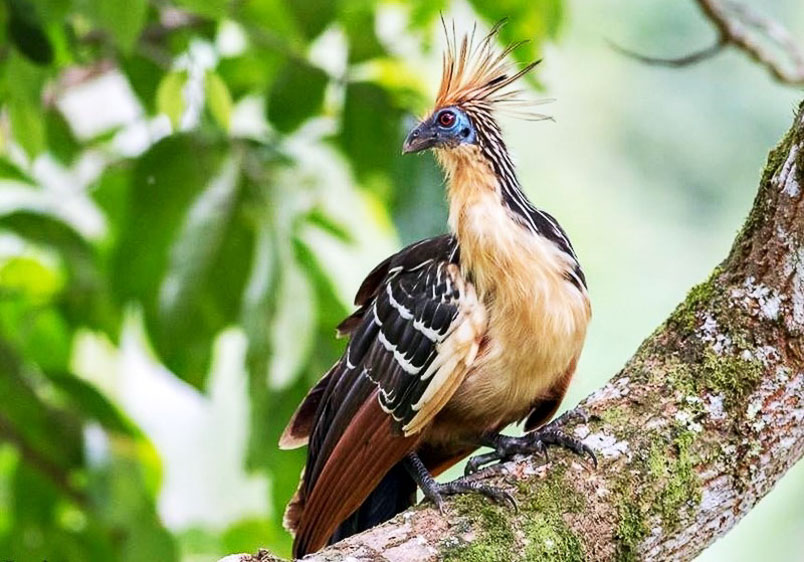
The monotypic Hoatzin was seen nicely on this tour (photo Noah Frade).
Our visit to El Escondite allowed us to get two interesting primate sightings. First, a group of the Colombian-endemic and range-restricted Colombian Black-crowned (Medem’s) Titi, which was seen nicely. Second, a large troop of Humboldt’s Squirrel Monkeys putting up a characteristic performance while travelling across the forest subcanopy above us.
After the morning birding at El Escondite we started out for our next destination. Leaving Mocoa, we managed to get our first Scarlet Ibis of the trip – apparently, they have started to colonize the Amazon foothills from the eastern Llanos. We arrived in Puerto Asís, where we were scheduled to stay for two nights, and decided to have another easy afternoon as the weather was not improving.
Day 9, 16th February 2023. Putumayo River tributary and Playa Rica
I took the group for a pleasant surprise after I heard that Amazon (Pink) River Dolphins were almost guaranteed along a tributary of the Putumayo River. We took an hour-and-a-half-long speedboat trip along the Putumayo River, at times a few meters from the Ecuadorian border. The group did not expect this at all, since I was covering the surprise with a veil of mystery until the very last minute. I had the freedom to take a decision like this because I knew the group very well, having travelled with them on various occasions and enjoying a friendly relationship. I knew they would love the experience of seeing this amazing and very unexpected creature.
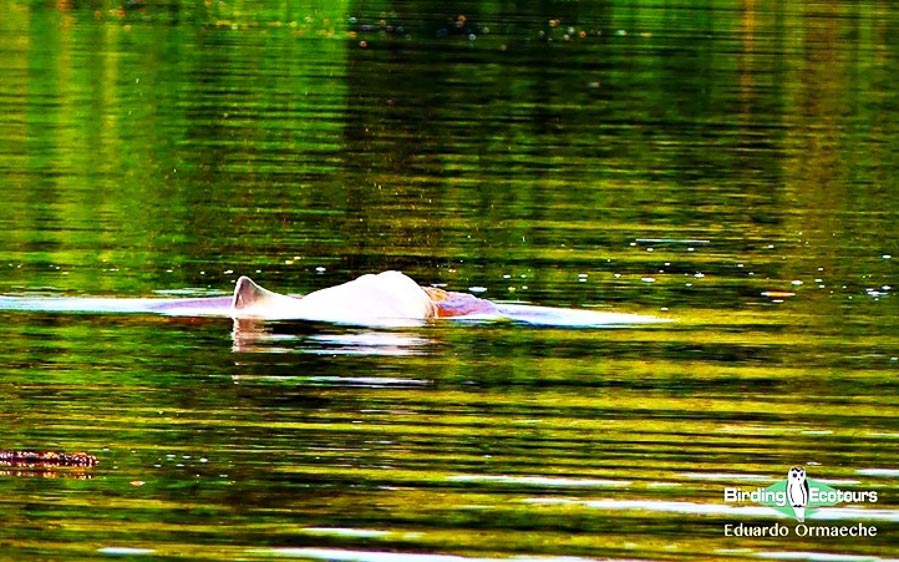
Amazon (Pink) River Dolphins were the wildlife surprise of the trip.
During the boat trip, we saw some interesting birds, such as Mottled-backed Elaenia, White-winged Swallow, Amazon and Ringed Kingfishers, Rufescent Tiger Heron, Horned Screamer, Pied Plover, Black-bellied Whistling Duck, and Masked Crimson Tanager, which was new for the trip and the group was very happy to see. We also had White-banded Swallow, Red-capped Cardinal, and Black-capped Donacobius, and we heard Riparian Antbird, and Great Antshrike.We found the dolphins and, although it was difficult to take good photos because they were constantly moving, spending more time under water, and only coming up for short periods to breathe, everyone loved the experience.
After this little adventure, we went directly to Playa Rica, our hotspot for the day. We arrived a little later than expected, but still nailed some great birds, including the most-wanted Rufous-headed Woodpecker, the fantastic Long-billed Woodcreeper, White-eared Jacamar, Scarlet-crowned and Lemon-throated Barbets, Black-crowned Tityra, Blue-headed Parrot, Cobalt-winged Parakeet, and Yellow-tufted Woodpecker.In addition to the birds, we were fortunate to find a Red (-crowned) Titi Monkey.After lunch,we returned to Puerto Asis and took the afternoon off. In the evening we ate a last supper with Johnny, our main driver since the start of the trip. This was the end of the first leg of our trip and we were to catch a flight the next day for the second leg of our adventure.
Day 10, 17th February 2023. Flight to Bogota and Observatorio de Colibríes
After a very short drive we arrived at Puerto Asis airport to catch our flight to Bogota. We had a smooth flight and after arrival in Bogota, we headed to La Calera town to visit the famous Observatorio de Colibríes. The driving was slow due to weekend traffic, as the people living in Bogota like to get out of the city and enjoy a country lunch and chill out. There was also rain and roadworks, delaying us further. From the van window, we got excellent views of Streak-throated Bush Tyrant. We arrived at the feeding garden and some of the participants went into raptures when they saw how many high-elevation and sought-after hummingbird species were around, some of them difficult to see anywhere else. Additionally, this lovely private house boasts strikingly beautiful garden designs. Some of the spectacular species we saw included the impressive Great Sapphirewing, the striking Blue-throated Starfrontlet, Longuemare’s Sunangel, Black-tailed Trainbearer, Tyrian Metaltail, White-bellied Woodstar, Sparkling Violetear, Glowing Puffleg, and the most-wanted Sword-billed Hummingbird, which made Sue very happy. Other birds seen around the gardens included Great Thrush, Rufous-collared Sparrow and Glossy Flowerpiercer. We then returned to Bogota for the night.
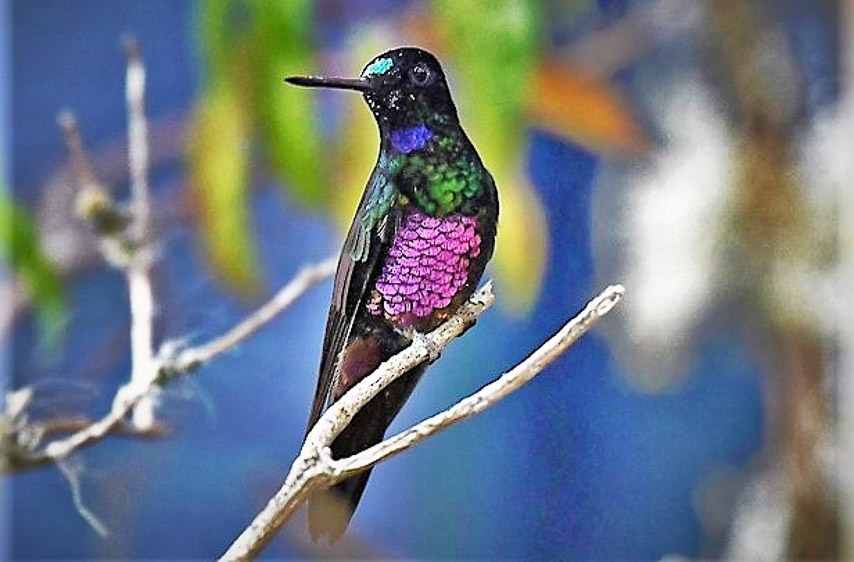
Blue-throated Starfrontlet was the star of the Observatorio de Colibríes (photo Alejandro Grajales).
Day 11, 18th February 2023. Yopal rest day
We were transferred to El Dorado airport in Bogota and caught our short flight to Yopal, where we stayed for the rest of the day, resting and preparing for the intensity of the next few days. Since there were no direct flights between Puerto Asis and Yopal, this “rest” day was necessary to allow us to do the five-hour drive from Yopal to Juan Solito Lodge (the heart of the Colombian Llanos) at a relaxed pace during the prime hours of the day.
Day 12, 19th February 2023. Los Llanos and Juan Solito Lodge
We were fetched from our hotel in Yopal in two 4×4 vehicles and started our drive to Juan Solito. We had hoped we could get some of our targets and interesting species on the way to the lodge, but the drive far exceeded our expectations. We wished we could have spent longer enjoying the birds and taking photos!
We scored with a large diversity of waterbirds, including the handsome, most-wanted and here, relatively common, Orinoco Goose. We got excited with several sightings of the localized Sharp-tailed Ibis. We alsoenjoyed views of White-headed Marsh Tyrant, Carib Grackle, Tropical Mockingbird, Horned Screamer, Black-necked Stilt, large numbers of Black-bellied Whistling Duck, our first Roseate Spoonbill, Yellow-headed and Crested Caracaras, Jabiru, a couple of Maguari Storks, Savanna Hawk, and Scarlet Ibis.
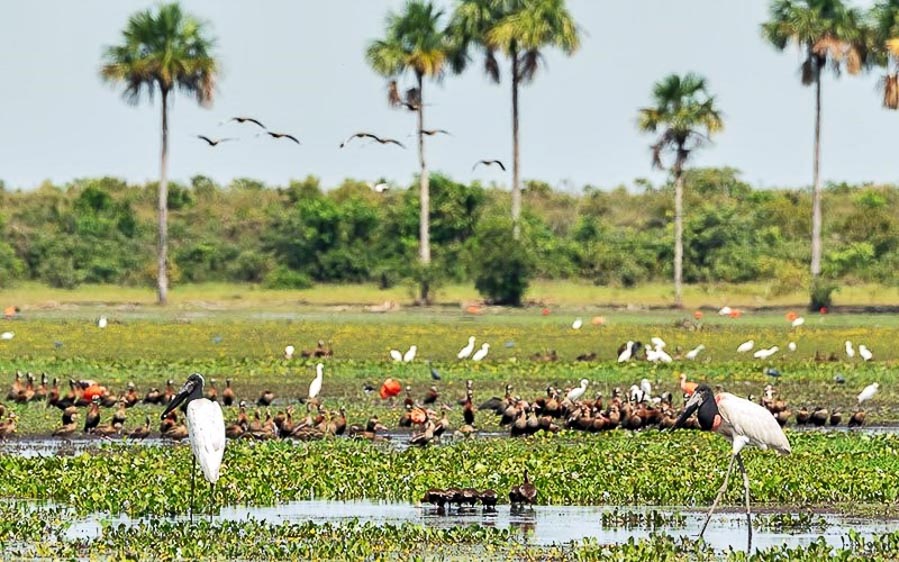
Los Llanos (photo Alejandro Grajales).
During the dry season only a few ponds of water remain, harboring a plethora of aquatic species in high concentrations – as can be seen in the image above – and this is the perfect time to visit Los Llanos. Los Llanos (“the plains”) is a vast tropical grassland plain situated to the east of the Andes in Colombia and Venezuela. Most of it is located in Venezuela however not many eco-travelers are aware that Colombia offers excellent access to this unique biome.
We arrived at Juan Solito Lodge, and after check in were introduced to our local guide and field assistants for our stay in Juan Solito. We stayed in the clearing at the lodge to explore the surroundings and it could not have been better! We found many of the localized targets for this region, including the most-wanted Pale-headed Jacamar, Orange-fronted Yellow Finch, Rufous-vented Chachalaca, Ruddy Ground Dove, Pale-vented Pigeon, Versicolored Emerald, Chestnut-eared Aracari, Scaled Piculet, Lineated Woodpecker, Short-crested Flycatcher, Violaceous Jay, Masked Cardinal (found only in Colombia, Venezuela and Trinidad), Spectacled Thrush, a female Blue Ground Dove (only for some of us), and the localized White-bearded Flycatcher. We were very happy to find a Great Potoo roosting in a dead tree during the day (well done Tracy). There were birds everywhere and we enjoyed being away from the city and completely surrounded by nature for a few days.
After a long day, we enjoyed a quick shower, supper, worked on our daily checklist, and made plans for the following day. There was much excitement, and with those thoughts we said goodnight.
Day 13, 20th February 2023. Birding around Juan Solito
We went for a walk before breakfast hoping to see Giant Anteater, which can be reliable in the area, but didn’t find it. We however enjoyed views of Double-striped Thick-knee, Grey Seedeater, Blue-black Grassquit, Southern Beardless Tyrannulet, Olive-grey Saltator, Yellow-browed Sparrow, Oriole Blackbird, Orange-fronted Yellow Finch, and Rufous-fronted Thornbird next to its massive nest. Furthermore, we found Pale-eyed Pygmy Tyrant playing hide-and-seek, Short-crested Flycatcher, White-fringed Antwren, Spectacled Parrotlet, Brown-throated Parakeet and Chestnut-fronted Macaw.
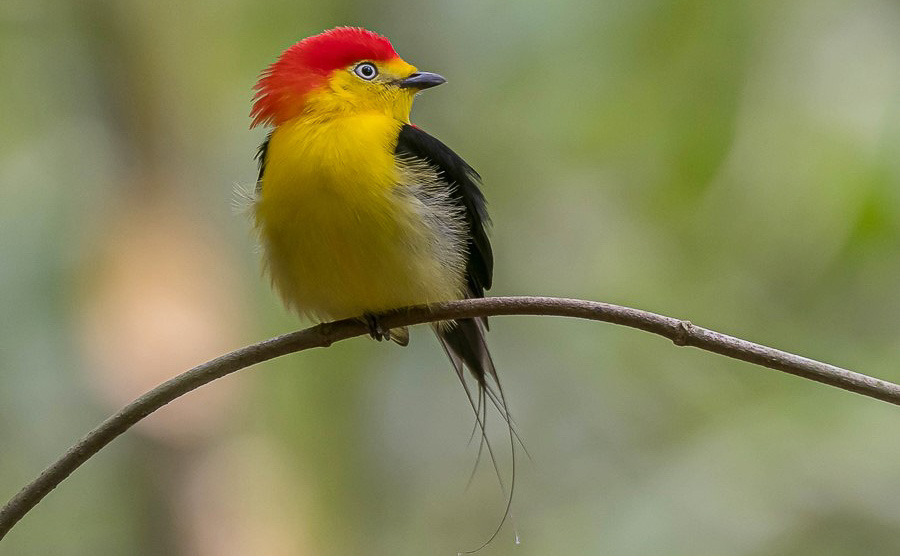
Wire-tailed Manakin was one of the stars at Los Llanos (photo Alejandro Grajales).
After breakfast, we went to explore some gallery forest looking for interior forest species. The activity was slow and quiet, adding Straight-billed Woodcreeper, followed by Pale-breasted Spinetail, Lineated Woodpecker, Dusky-capped Flycatcher, and Chestnut-eared Aracari. One of the stars was Wire-tailed Manakin for which we had to work hard to get all the participants onto, as the male manakin was shy, mostly remaining hidden from us. We were happy with good views, including its tail, although taking photographs proved difficult.
Laura, our field assistant, spotted a Collared Forest Falcon near the trail while she was trying to provide the photographers a better opportunity with the manakin. Laura and I worked together, trying to find a good position and eventually this elusive and shy raptor came out into view. We feasted our eyes on this sighting, with everyone trying to get photographs and admiring its behavior. Great was our surprise when we saw its mate arriving, having a pair was a real treat! After this sighting, there was not much activity in the forest and so we returned to the lodge clearing. We looked for birds from the river stakeout, where we added Pale-headed Jacamar, Grey-fronted Dove, Sunbittern, Green Ibis, Spot-breasted and Crimson-crested Woodpeckers and Orange-winged Amazon.
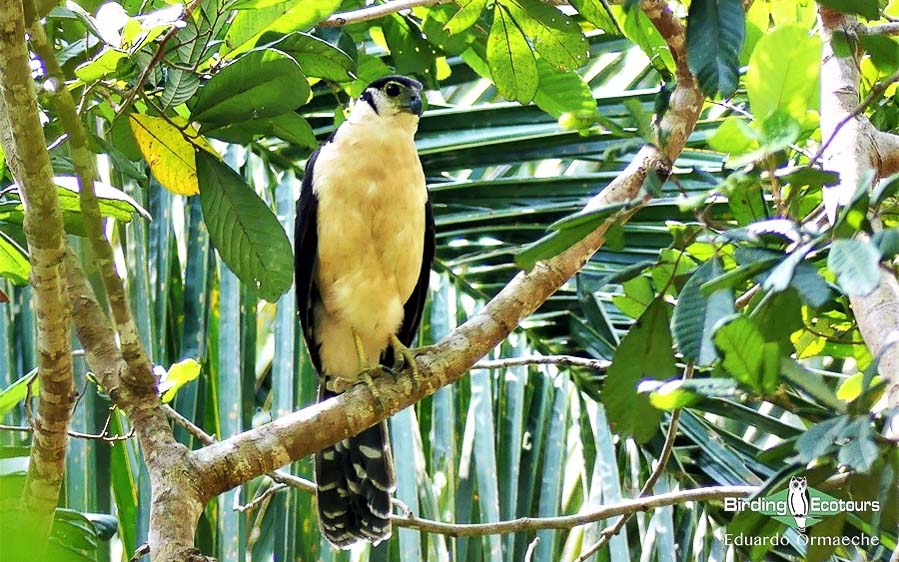
A highlight of Juan Solito was the secretive Collared Forest Falcon.
We also saw other wildlife, such as Capybaras and some Spectacled Caimans, the more common crocodilian in this part of Los Llanos in Casanare. The special Orinoco Crocodile is scarcer and we were hoping to see some in the upcoming days, together with the mythical Green Anaconda.
We spent the afternoon on a 4×4-vehicle excursion, exploring some of the dry plains and looking for Yellowish Pipit. We planned to check a small lagoon for aquatic species and wait until sunset, hoping for mammals coming to drink. Our first score was a nice pair of Burrowing Owls along the track. We tried hard for Yellowish Pipit but we did not find it, unfortunately. At the lagoon we added lots of aquatic species, completing all potential birds in Los Llanos, with a list including Snowy and Great Egrets, Little Blue, Rufescent Tiger, Striated, Cocoi, and Whistling Herons, Jabiru, Wood and Maguari Storks, and Bare-faced, Green, American White, Scarlet and Sharp-tailed Ibises. We were hoping for Glossy Ibis only because we had not seen it yet but unfortunately, they did not oblige today. In addition, we saw Black-bellied Whistling Duck, Blue-winged and Brazilian Teals, Wattled Jacana, Pied Plover, and the monotypic Limpkin.We added Least and Solitary Sandpipers, Greater and Lesser Yellowlegs, Yellow-billed and Large-billed Terns and Black Skimmer.
At sundown, we enjoyed a bottle of white wine with snacks. We had views of Red Brocket deer, which was relatively common in the area and there was a habituated individual at the lodge. Perhaps one of the most memorable experiences, amongst the breathtaking natural scenery, was the ‘red leaf tree’. Humorously, the tree was red because it was full of roosting Scarlet Ibises – a special moment,as this species was a target for many of our participants.
On the drive back to the lodge we managed to get great views of Crab-eating Fox.Before supper we triedfor Tropical Screech Owl,which we heard near the cabins, but it did not want to answer this time. Nevertheless, Mike managed good views when he woke up during the night, with a photograph to prove it! Before I went to my room, I saw a huge Common Opossum but, sadly, nobody else in our group saw it.
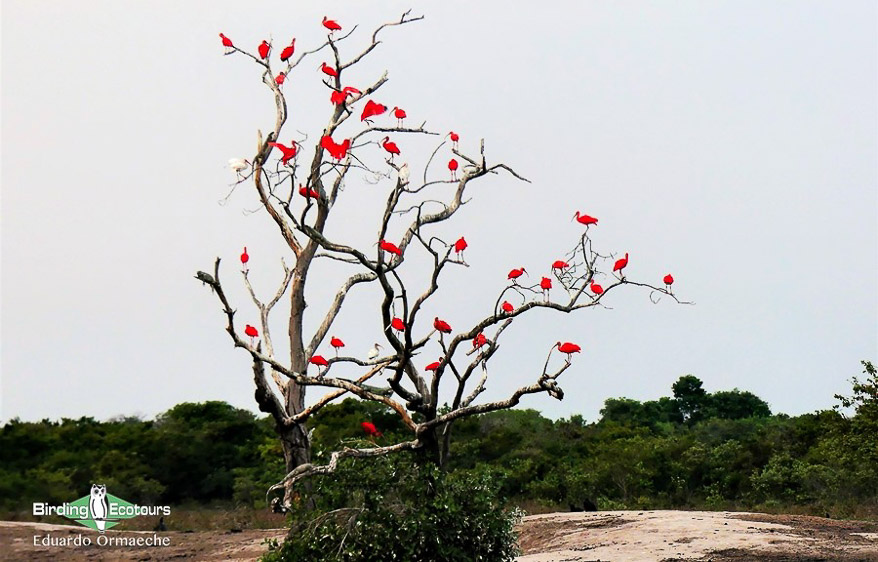
Scarlet Ibises preparing to roost in a tree in Juan Solito.
Day 14, 21st February 2023. Hato de La Aurora and wetland birding
We planned to repeat the same formula of birding and exploring the surroundings for an hour, before returning for breakfast. Suddenly Giovani, our local guide and a true llanero, shouted, “anteater”! We dropped everything and had excellent, close views of Giant Anteater, one of the big five animals of South America. We had seen this amazing creature on our Brazil and Peru tours and recently in Guyana, but this was our first time finding one in Colombia. The light was not ideal and the anteater was moving briskly, but everyone was ecstatic with this sighting.
We birded the surroundings and saw some of the usual suspects, seen on previous days, and some new birds, such as White-tipped Dove, Striped Cuckoo, Southern Mealy Amazon, and a nice surprise was a Two-banded Puffbird.This isa recent split from Russet-throated Puffbird, which is almost a Venezuela endemic but reaches the Colombian Llanos as the western range of its distribution.
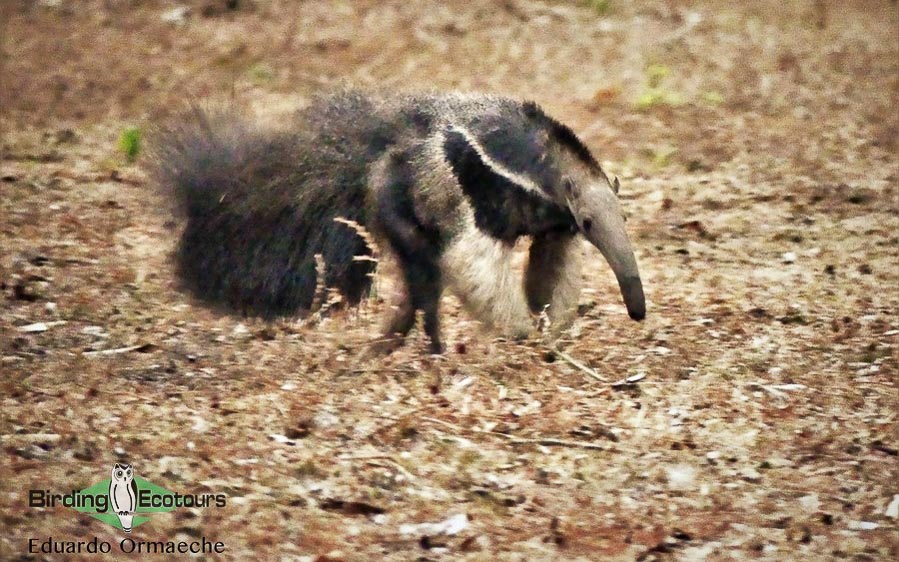
Giant Anteater was a wildlife highlight of the trip.
After breakfast, we started a 4×4-vehicle drive towards Hato de La Aurora, in the deep heart of the Colombian Llanos, where we would spend the full day and return in the evening. On the way to Hato de La Aurora, we stopped at a seasonal lagoon, where we saw the Critically Endangered Orinoco Crocodile. We could study it in great detail, comparing it to the Spectacled Caimanwe had seen previously. We then went looking for something some of the participants were dreaming of seeing, the mythical Green Anaconda.Even though it is widespread across the continent it is not easy to see, and Los Llanos is the place with the highest likelihood. Our local guide, Giovani, together with the driver (both men born in Los Llanos and thus experts), looked for it in a swamp they knew. An individual had been reported recently and, walking in the swamp with feet under the muddy water, they managed to find one, which came out of hiding and showed for us. We would certainly remember this experience for the rest of our lives!
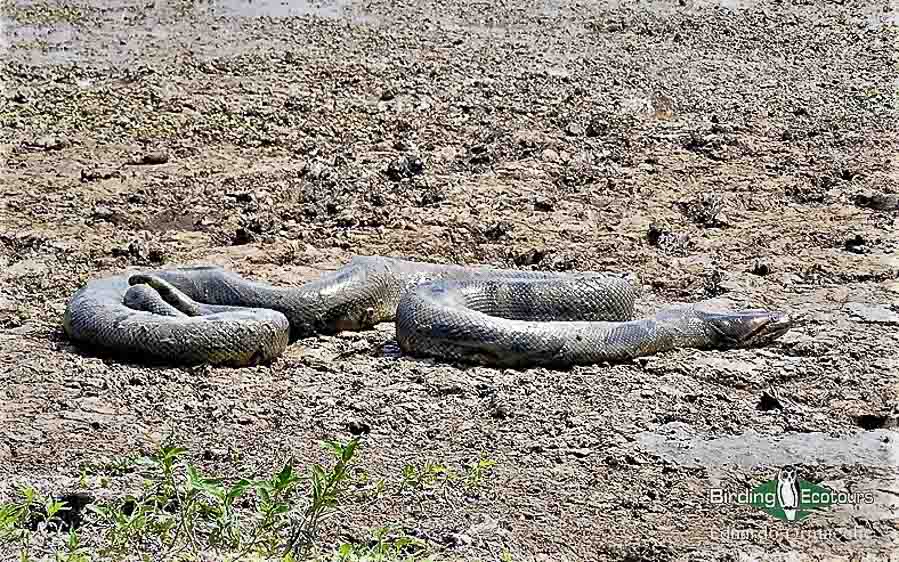
The Green Anaconda seen in Los Llanos.
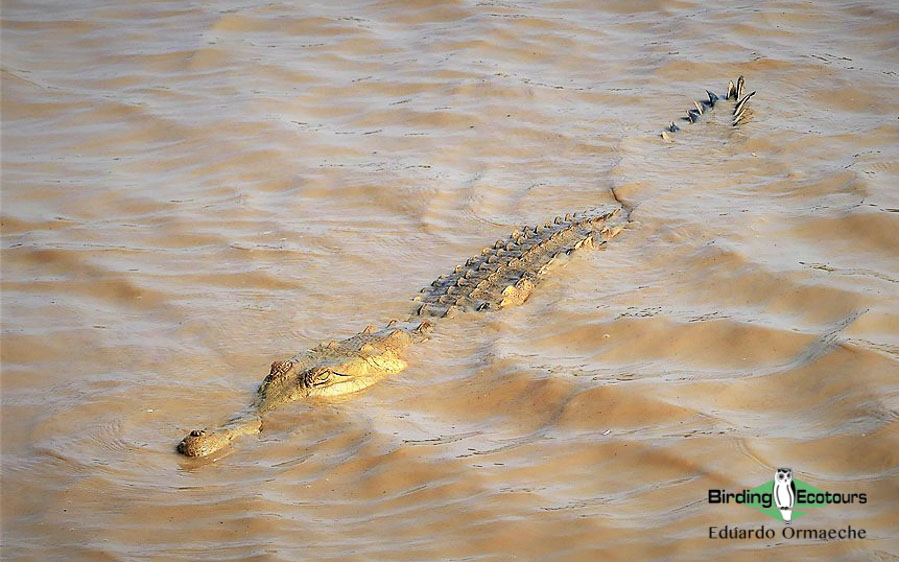
The Critically Endangered Orinoco Crocodile seen in Hato de La Aurora.
After the big herping moment with these two impressive reptiles, we arrived at Hato de La Aurora hacienda for lunch and enjoyed the garden feeders. Hato de La Aurora is a huge hacienda property with the highest density of Jaguars in the Colombian Llanos, and where conservationist and researcher, Mr. Jorge Barragan, has been conducting a study on the Jaguar population in the area for the last 20 years. We had the opportunity to meet him and listen to a short, fascinating talk about his work in Hato de La Aurora. Before and after lunch we looked for birds around the garden and had Masked Cardinal, Bicolored Wren, Versicolored Emerald, Red-crowned Woodpecker, Chestnut-eared Aracari, Violaceous Jay, Tropical Mockingbird, Thick-billed Euphonia, Silver-beaked Tanager, Olive-grey Saltator, and Venezuelan Troupial.
After lunch and a short break, we drove in our 4×4 vehicles to a distant wetland where jaguars had recently been photographed on a camera trap. On the way, we managed to see Eastern Meadowlark, a new bird for the trip, plus Burrowing Owl. We arrived at the spot and waited in silence for over an hour with the hope of seeing Jaguars. In the meantime, we got good views of Savanna and Black-collared Hawks, and Turkey and Lesser Yellow-headed Vultures.Time was running out and we were about to leave when we had a super sighting of a pair of Crestless Curassows which, although distant, provided good views of this shy species. We left the wetland and looked in another lagoon where, in addition to all the usual aquatic species and dozens of Capybaras, we managed to spot a single Glossy Ibis, which showed nicely in the scope. It was then time to start the long and dusty drive back to Juan Solito. Along the drive, we had good views of Crab-eating Foxes as well as Nacunda Nighthawk, Parauque and Spot-tailed Nightjar.
We arrived back in Juan Solito, and after supper we were surprised to be invited to participate in a birthday party for one of the lodge staff members. It was a brief but very interesting opportunity to experience local customs, especially the local musical traditions which had a unique style.
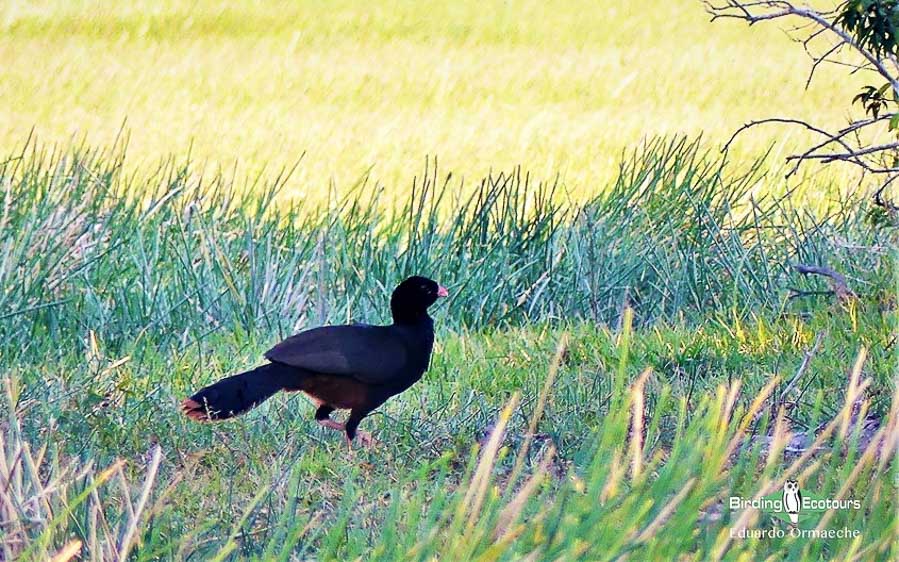
Crestless Curassow was a great find in Hato de La Aurora in the Colombian Llanos.
Day 15, 22nd February 2023. Juan Solito Lodge area and return to Yopal
We had an easy morning hanging around the lodge clearing, trying for Spectacled Thrush, which unfortunately did not show. We got all the usual birds around the clearing, including Scaled Dove, Carib Grackle, Masked Cardinal and Rufous-vented Chachalaca. We got nice views of White-bearded Manakin and Pale-headed Jacamar for the last time, as well as a Southern Tamandua which was a lovely surprise before we hit the road back to Yopal. It was great to see this awesome creature so well and for so long. It did not seem to be bothered by our presence, it seemed very relaxed, looking for termites, and climbing down a tree. We then drove back to Yopal for the night.
Day 16, 23rd February 2023. Flight to Bogota and departure
We caught our flight from Yopal to Bogota where our fantastic 16-day Colombian birding tour would end. All the participants had decided to stay extras nights in Bogota in order to get their international connections, or do some tours around the city.
Everyone enjoyed this Colombia Uncovered birding tour, despite all the last-minute changes, due to the landslides, described in the first part of this report. As I am writing these lines, I’m still unsure whether we should revert to the original itinerary or keep this modified version. The modified version seems to be perfect for reaching the best bird and wildlife experience in southern and eastern Colombia. Perhaps we would have to rename the tour to Wild Colombia, though. It was a great trip and we hope to return to Colombia soon.
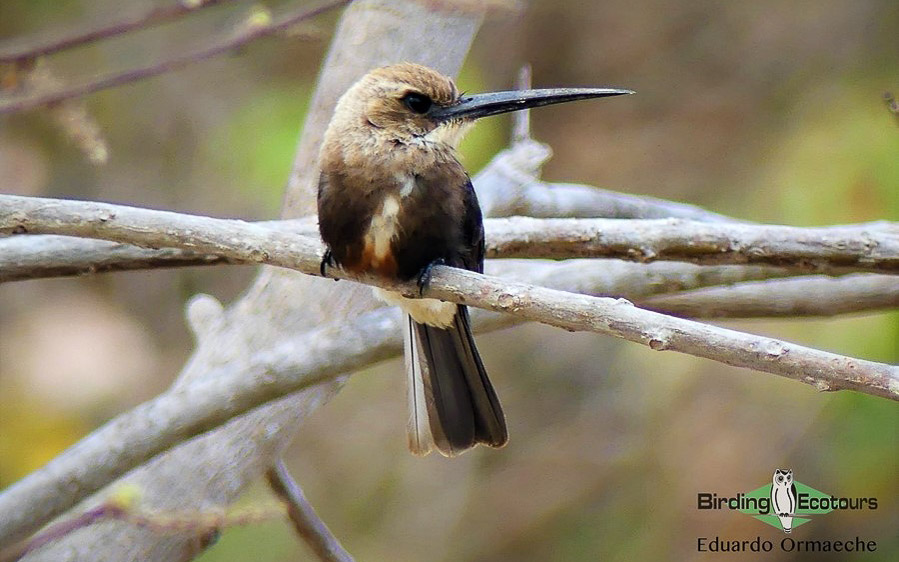
Pale-headed Jacamar, restricted to Los Llanos in Colombia and Venezuela.
Bird List – Following IOC (12.2)
Birds ‘heard only’ are marked with (H) after the common name, all other species were seen.
The following notation after species names is used to show conservation status following BirdLife International: VU = Vulnerable.
| Common Name | Scientific Name |
| Tinamidae | |
| Cinereous Tinamou (H) | Crypturellus cinereus |
| Little Tinamou (H) | Crypturellus soui |
| Anhimidae | |
| Horned Screamer | Anhima cornuta |
| Anatidae | |
| White-faced Whistling Duck | Dendrocygna viduata |
| Black-bellied Whistling Duck | Dendrocygna autumnalis |
| Torrent Duck | |
| Orinoco Goose | Neochen jubata |
| Brazilian Teal | Amazonetta brasiliensis |
| Cinnamon Teal | Spatula cyanoptera |
| Blue-winged Teal | Spatula discors |
| Masked Duck | Nomonyx dominicus |
| Cracidae | |
| Rufous-vented Chachalaca | Ortalis ruficauda |
| Speckled Chachalaca | Ortalis guttata |
| Colombian Chachalaca (Endemic) | Ortalis Columbiana |
| Sickle-winged Guan | Chamaepetes goudotii |
| Crestless Curassow | Mitu tomentosum |
| Odontophoridae | |
| Chestnut Wood Quail (Endemic) | Odontophorus hyperythrus |
| Caprimulgidae | |
| Nacunda Nighthawk | Chordeiles nacunda |
| Pauraque | Nyctidromus albicollis |
| Spot-tailed Nightjar | Hydropsalis maculicaudus |
| Nyctibiidae | |
| Great Potoo | Nyctibius grandis |
| Common Potoo | Nyctibius griseus |
| Apodidae | |
| Chestnut-collared Swift | Streptoprocne rutile |
| White-collared Swift | Streptoprocne zonaris |
| Short-tailed Swift | Chaetura brachyuran |
| Neotropical Palm Swift | Tachornis squamata |
| Trochilidae | |
| White-necked Jacobin | Florisuga mellivora |
| Green Hermit | Phaethornis guy |
| White-bearded Hermit | Phaethornis hispidus |
| Tawny-bellied Hermit | Phaethornis syrmatophorus |
| Brown Violetear | Colibri delphinae |
| Lesser Violetear | Colibri cyanotus |
| Sparkling Violetear | Colibri coruscans |
| White-tailed Goldenthroat | Polytmus guainumbi |
| Black-throated Mango | Anthracothorax nigricollis |
| Longuemare’s Sunangel | Heliangelus clarisse |
| Gorgeted Sunangel | Heliangelus strophianus |
| Wire-crested Thorntail | Discosura popelairii |
| Speckled Hummingbird | Adelomyia melanogenys |
| Long-tailed Sylph | Aglaiocercus kingii |
| Black-tailed Trainbearer | Lesbia victoriae |
| Tyrian Metaltail | Metallura tyrianthina |
| Greenish Puffleg | Haplophaedia aureliae |
| Glowing Puffleg | Eriocnemis vestita |
| Bronzy Inca | Coeligena coeligena |
| Blue-throated Starfrontlet | Coeligena helianthea |
| Mountain Velvetbreast | Lafresnaya lafresnayi |
| Sword-billed Hummingbird | Ensifera ensifera |
| Great Sapphirewing | Pterophanes cyanopterus |
| Buff-tailed Coronet | Boissonneaua flavescens |
| Chestnut-breasted Coronet | Boissonneaua matthewsii |
| White-booted Racket-tail | Ocreatus underwoodii |
| Fawn-breasted Brilliant | Heliodoxa rubinoides |
| Green-crowned Brilliant | Heliodoxa jacula |
| Violet-fronted Brilliant | Heliodoxa leadbeateri |
| Purple-throated Woodstar | Philodice mitchellii |
| White-bellied Woodstar | Chaetocercus mulsant |
| Gorgeted Woodstar | Chaetocercus heliodor |
| Short-tailed Emerald | Chlorostilbon poortmani |
| Western Emerald | Chlorostilbon melanorhynchus |
| Tolima Blossomcrown (Endemic) – VU | Anthocephala berlepschi |
| Grey-breasted Sabrewing | Campylopterus largipennis |
| White-vented Plumeleteer | Chalybura buffonii |
| Crowned Woodnymph | Thalurania colombica |
| Fork-tailed Woodnymph | Thalurania furcata |
| Steely-vented Hummingbird | Saucerottia saucerottei |
| Indigo-capped Hummingbird (Endemic) | Saucerottia cyanifrons |
| Rufous-tailed Hummingbird | Amazilia tzacatl |
| Andean Emerald | Uranomitra franciae |
| Shining-green Hummingbird | Chrysuronia goudoti |
| Golden-tailed Sapphire | Chrysuronia oenone |
| Red-billed Emerald | Chlorostilbon gibsoni |
| Versicolored Emerald | Chrysuronia versicolor |
| Glittering-throated Emerald | Chionomesa fimbriata |
| Cuculidae | |
| Greater Ani | Crotophaga major |
| Smooth-billed Ani | Crotophaga ani |
| Striped Cuckoo | Tapera naevia |
| Squirrel Cuckoo | Piaya cayana |
| Columbidae | |
| Rock Dove (Introduced) | Columba livia |
| Band-tailed Pigeon | Patagioenas fasciata |
| Pale-vented Pigeon | Patagioenas cayennensis |
| Scaled Dove | Columbina squammata |
| Ruddy Ground Dove | Columbina talpacoti |
| Blue Ground Dove | Claravis pretiosa |
| White-tipped Dove | Leptotila verreauxi |
| Grey-fronted Dove | Leptotila rufaxilla |
| Tolima Dove (Endemic) | Leptotila conoveri |
| White-throated Quail-Dove | Zentrygon frenata |
| Eared Dove | Zenaida auriculata |
| Rallidae | |
| Grey-cowled Wood Rail | Aramides cajaneus |
| Sora | Porzana carolina |
| Common Gallinule | Gallinula galeata |
| Purple Gallinule | Porphyrio martinica |
| White-throated Crake | Laterallus albigularis |
| Aramidae | |
| Limpkin | Aramus guarauna |
| Burhinidae | |
| Double-striped Thick-knee | Burhinus bistriatus |
| Recurvirostridae | |
| Black-necked Stilt | Himantopus mexicanus |
| Charadriidae | |
| Southern Lapwing | Vanellus chilensis |
| Pied Plover | Hoploxypterus cayanus |
| Jacanidae | |
| Wattled Jacana | Jacana jacana |
| Scolopacidae | |
| Least Sandpiper | Calidris minutilla |
| Wilson’s Snipe | Gallinago delicata |
| Spotted Sandpiper | Actitis macularius |
| Solitary Sandpiper | Tringa solitaria |
| Lesser Yellowlegs | Tringa flavipes |
| Greater Yellowlegs | Tringa melanoleuca |
| Laridae | |
| Black Skimmer | Rynchops niger |
| Yellow-billed Tern | Sternula superciliaris |
| Large-billed Tern | Phaetusa simplex |
| Eurypygidae | |
| Sunbittern | Eurypyga helias |
| Ciconiidae | |
| Wood Stork | Mycteria americana |
| Maguari Stork | Ciconia maguari |
| Jabiru | Jabiru mycteria |
| Anhingidae | |
| Anhinga | Anhinga anhinga |
| Phalacrocoracidae | |
| Neotropic Cormorant | Nannopterum brasilianum |
| Threskiornithidae | |
| Buff-necked Ibis | Theristicus caudatus |
| Sharp-tailed Ibis | Cercibis oxycerca |
| Green Ibis | Mesembrinibis cayennensis |
| Bare-faced Ibis | Phimosus infuscatus |
| American White Ibis | Eudocimus albus |
| Scarlet Ibis | Eudocimus ruber |
| Glossy Ibis | Plegadis falcinellus |
| Roseate Spoonbill | Platalea ajaja |
| Ardeidae | |
| Rufescent Tiger Heron | Tigrisoma lineatum |
| Black-crowned Night Heron | Nycticorax nycticorax |
| Striated Heron | Butorides striata |
| Western Cattle Egret | Bubulcus ibis |
| Cocoi Heron | Ardea cocoi |
| Great Egret | Ardea alba |
| Whistling Heron | Syrigma sibilatrix |
| Little Blue Heron | Egretta caerulea |
| Snowy Egret | Egretta thula |
| Opisthocomidae | |
| Hoatzin | Opisthocomus hoazin |
| Cathartidae | |
| King Vulture | Sarcoramphus papa |
| Andean Condor – VU | Vultur gryphus |
| Black Vulture | Coragyps atratus |
| Turkey Vulture | Cathartes aura |
| Lesser Yellow-headed Vulture | Cathartes burrovianus |
| Greater Yellow-headed Vulture | Cathartes melambrotus |
| Pandionidae | |
| Western Osprey | Pandion haliaetus |
| Accipitridae | |
| White-tailed Kite | Elanus leucurus |
| Bicolored Hawk | Accipiter bicolor |
| Plumbeous Kite | Ictinia plumbea |
| Black-collared Hawk | Busarellus nigricollis |
| Savanna Hawk | Buteogallus meridionalis |
| Roadside Hawk | Rupornis magnirostris |
| Grey-lined Hawk | Buteo nitidus |
| Broad-winged Hawk | Buteo platypterus |
| Strigidae | |
| Burrowing Owl | Athene cunicularia |
| Ferruginous Pygmy Owl | Glaucidium brasilianum |
| Tropical Screech Owl | Megascops choliba |
| Band-bellied Owl | Pulsatrix melanota |
| Trogonidae | |
| Golden-headed Quetzal | Pharomachrus auriceps |
| Green-backed Trogon | Trogon viridis |
| Alcedinidae | |
| Amazon Kingfisher | Chloroceryle amazona |
| Green Kingfisher | Chloroceryle americana |
| Ringed Kingfisher | Megaceryle torquata |
| Momotidae | |
| Amazonian Motmot | Momotus momota |
| Andean Motmot | Momotus aequatorialis |
| Rufous Motmot | Baryphthengus martii |
| Galbulidae | |
| White-eared Jacamar | Galbalcyrhynchus leucotis |
| Pale-headed Jacamar | Brachygalba goeringi |
| Coppery-chested Jacamar – VU | Galbula pastazae |
| White-chinned Jacamar | Galbula tombacea |
| Bucconidae | |
| Two-banded Puffbird | Hypnelus bicinctus |
| Black-streaked Puffbird | Malacoptila fulvogularis |
| Black-fronted Nunbird | Monasa nigrifrons |
| Swallow-winged Puffbird | Chelidoptera tenebrosa |
| Capitonidae | |
| Scarlet-crowned Barbet | Capito aurovirens |
| Lemon-throated Barbet | Eubucco richardsoni |
| Red-headed Barbet | Eubucco bourcierii |
| Ramphastidae | |
| Crimson-rumped Toucanet | Aulacorhynchus haematopygus |
| White-throated Toucanet | Aulacorhynchus albivitta |
| Lettered Aracari | Pteroglossus inscriptus |
| Chestnut-eared Aracari | Pteroglossus castanotis |
| Grey-breasted Mountain Toucan | Andigena hypoglauca |
| White-throated Toucan (H) | Ramphastos tucanus |
| Yellow-throated Toucan | Ramphastos ambiguus |
| Picidae | |
| Scaled Piculet | Picumnus squamulatus |
| Acorn Woodpecker | Melanerpes formicivorus |
| Yellow-tufted Woodpecker | Melanerpes cruentatus |
| Red-crowned Woodpecker | Melanerpes rubricapillus |
| Little Woodpecker | Veniliornis passerinus |
| Smoky-brown Woodpecker | Leuconotopicus fumigatus |
| Golden-olive Woodpecker | Colaptes rubiginosus |
| Spot-breasted Woodpecker | Colaptes punctigula |
| Chestnut Woodpecker | Celeus elegans |
| Cream-colored Woodpecker | Celeus flavus |
| Rufous-headed Woodpecker | Celeus spectabilis |
| Lineated Woodpecker | Dryocopus lineatus |
| Crimson-crested Woodpecker | Campephilus melanoleucos |
| Falconidae | |
| Carunculated Caracara | Phalcoboenus carunculatus |
| Crested Caracara | Caracara plancus |
| Yellow-headed Caracara | Milvago chimachima |
| Laughing Falcon | Herpetotheres cachinnans |
| Collared Forest Falcon | Micrastur semitorquatus |
| American Kestrel | Falco sparverius |
| Psittacidae | |
| Sapphire-rumped Parrotlet | Touit purpuratus |
| Orange-chinned Parakeet | Brotogeris jugularis |
| Cobalt-winged Parakeet | Brotogeris cyanoptera |
| Blue-headed Parrot | Pionus menstruus |
| Bronze-winged Parrot | Pionus chalcopterus |
| Yellow-crowned Amazon | Amazona ochrocephala |
| Scaly-naped Amazon | Amazona mercenarius |
| Southern Mealy Amazon | Amazona farinosa |
| Orange-winged Amazon | Amazona amazonica |
| Spectacled Parrotlet | Forpus conspicillatus |
| Brown-throated Parakeet | Eupsittula pertinax |
| Dusky-headed Parakeet | Aratinga weddellii |
| Chestnut-fronted Macaw | Ara severus |
| Scarlet-fronted Parakeet | Psittacara wagleri |
| Furnariidae | |
| Cinnamon-throated Woodcreeper | Dendrexetastes rufigula |
| Long-billed Woodcreeper | Nasica longirostris |
| Buff-throated Woodcreeper | Xiphorhynchus guttatus |
| Straight-billed Woodcreeper | Dendroplex picus |
| Montane Woodcreeper | Lepidocolaptes lacrymiger |
| Orange-fronted Plushcrown | Metopothrix aurantiaca |
| Ash-browed Spinetail – VU | Cranioleuca curtata |
| Slaty Spinetail | Synallaxis brachyura |
| Dusky Spinetail (H) | Synallaxis moesta |
| Pale-breasted Spinetail | Synallaxis albescens |
| Azara’s Spinetail | Synallaxis azarae |
| Thamnophilidae | |
| Plain Antvireo (H) | Dysithamnus mentalis |
| Barred Antshrike | Thamnophilus doliatus |
| Lined Antshrike (H) – VU | Thamnophilus tenuepunctatus |
| Mouse-colored Antshrike (H) | Thamnophilus murinus |
| Black-crowned Antshrike | Thamnophilus atrinucha |
| Northern Slaty Antshrike (H) | Thamnophilus punctatus |
| Black-crested Antshrike | Sakesphorus canadensis |
| Great Antshrike (H) | Taraba major |
| East Andean Antbird (Endemic) | Drymophila caudata |
| Western Fire-eye | Pyriglena maura |
| Grallariidae | |
| Scaled Antpitta (H) | Grallaria guatimalensis |
| White-bellied Antpitta | Grallaria hypoleuca |
| Hooded Antpitta – VU | Grallaricula cucullata |
| Rhinocryptidae | |
| Nariño Tapaculo (H) | Scytalopus vicinior |
| Tyrannidae | |
| Yellow-bellied Elaenia | Elaenia flavogaster |
| Mottle-backed Elaenia | Elaenia gigas |
| Southern Beardless Tyrannulet | Camptostoma obsoletum |
| Mouse-colored Tyrannulet | Phaeomyias murina |
| Golden-faced Tyrannulet | Zimmerius chrysops |
| Slaty-capped Flycatcher | Leptopogon superciliaris |
| Scale-crested Pygmy Tyrant | Lophotriccus pileatus |
| Pale-eyed Pygmy Tyrant | Atalotriccus pilaris |
| Golden-winged Tody-Flycatcher | Poecilotriccus calopterus |
| Spotted Tody-Flycatcher | Todirostrum maculatum |
| Common Tody-Flycatcher | Todirostrum cinereum |
| Yellow-browed Tody-Flycatcher | Todirostrum chrysocrotaphum |
| Ochre-lored Flatbill | Tolmomyias flaviventris |
| Olive-sided Flycatcher | Contopus cooperi |
| Smoke-colored Pewee | Contopus fumigatus |
| Eastern Wood Pewee | Contopus virens |
| Acadian Flycatcher | Empidonax virescens |
| Vermillion Flycatcher | Pyrocephalus obscurus |
| Streak-throated Bush Tyrant | Myiotheretes striaticollis |
| Pied Water Tyrant | Fluvicola pica |
| White-headed Marsh Tyrant | Arundinicola leucocephala |
| Slaty-backed Chat-Tyrant | Ochthoeca cinnamomeiventris |
| Cattle Tyrant | Machetornis rixosa |
| Piratic Flycatcher | Legatus leucophaius |
| White-bearded Flycatcher | Phelpsia inornata |
| Rusty-margined Flycatcher | Myiozetetes cayanensis |
| Social Flycatcher | Myiozetetes similis |
| Grey-capped Flycatcher | Myiozetetes granadensis |
| Great Kiskadee | Pitangus sulphuratus |
| Lemon-browed Flycatcher – VU | Conopias cinchoneti |
| Boat-billed Flycatcher | Megarynchus pitangua |
| Tropical Kingbird | Tyrannus melancholicus |
| Fork-tailed Flycatcher | Tyrannus savana |
| Dusky-capped Flycatcher | Myiarchus tuberculifer |
| Swainson’s Flycatcher | Myiarchus swainsoni |
| Short-crested Flycatcher | Myiarchus ferox |
| Apical Flycatcher (Endemic) | Myiarchus apicalis |
| Great Crested Flycatcher | Myiarchus crinitus |
| Large-headed Flatbill (H) | Ramphotrigon megacephalum |
| Cinnamon Attila (H) | Attila cinnamomeus |
| Cotingidae | |
| Andean Cock-of-the-rock | Rupicola peruvianus |
| Purple-throated Fruitcrow | Querula purpurata |
| Amazonian Umbrellabird | Cephalopterus ornatus |
| Bare-necked Fruitcrow | Gymnoderus foetidus |
| Pipridae | |
| Golden-winged Manakin | Masius chrysopterus |
| Wire-tailed Manakin | Pipra filicauda |
| Tityridae | |
| Black-crowned Tityra | Tityra inquisitor |
| Black-tailed Tityra | Tityra cayana |
| White-winged Becard | Pachyramphus polychopterus |
| Vireonidae | |
| Rufous-naped Greenlet | Pachysylvia semibrunnea |
| Chivi Vireo | Vireo chivi |
| Brown-capped Vireo | Vireo leucophrys |
| Corvidae | |
| Violaceous Jay | Cyanocorax violaceus |
| Inca Jay | Cyanocorax yncas |
| Hirundinidae | |
| White-winged Swallow | Tachycineta albiventer |
| White-banded Swallow | Atticora fasciata |
| Blue-and-white Swallow | Pygochelidon cyanoleuca |
| Southern Rough-winged Swallow | Stelgidopteryx ruficollis |
| Grey-breasted Martin | Progne chalybea |
| Barn Swallow | Hirundo rustica |
| Donacobiidae | |
| Black-capped Donacobius | Donacobius atricapilla |
| Troglodytidae | |
| Bicolored Wren | Campylorhynchus griseus |
| Thrush-like Wren | Campylorhynchus turdinus |
| Rufous-and-white Wren (H) | Thryophilus rufalbus |
| House Wren | Troglodytes aedon |
| Grey-breasted Wood Wren | Henicorhina leucophrys |
| Chestnut-breasted Wren | Cyphorhinus thoracicus |
| Mimidae | |
| Tropical Mockingbird | Mimus gilvus |
| Turdidae | |
| Swainson’s Thrush | Catharus ustulatus |
| Great Thrush | Turdus fuscater |
| Black-billed Thrush | Turdus ignobilis |
| Pale-breasted Thrush | Turdus leucomelas |
| Spectacled Thrush | Turdus nudigenis |
| Orange-billed Nightingale-Thrush (H) | Catharus auratiirostris |
| Cinclidae | |
| White-capped Dipper | Cinclus leucocephalus |
| Passeridae | |
| House Sparrow (Introduced) | Passer domesticus |
| Fringillidae | |
| Lesser Goldfinch | Spinus psaltria |
| Blue-naped Chlorophonia (H) | Chlorophonia cyanea |
| Velvet-fronted Euphonia (Endemic) | Euphonia concinna |
| White-vented Euphonia | Euphonia minuta |
| Thick-billed Euphonia | Euphonia laniirostris |
| Orange-bellied Euphonia | Euphonia xanthogaster |
| Bronze-green Euphonia | Euphonia mesochrysa |
| Passerellidae | |
| Yellow-whiskered Bush Tanager | Chlorospingus parvirostris |
| Yellow-browed Sparrow | Ammodramus aurifrons |
| Orange-billed Sparrow (H) | Arremon aurantiirostris |
| Chestnut-capped Brushfinch | Arremon brunneinucha |
| Rufous-collared Sparrow | Zonotrichia capensis |
| Icteridae | |
| Eastern Meadowlark | Sturnella magna |
| Russet-backed Oropendola | Psarocolius angustifrons |
| Crested Oropendola | Psarocolius decumanus |
| Yellow-backed Oriole | Icterus chrysater |
| Yellow Oriole | Icterus nigrogularis |
| Venezuelan Troupial | Icterus Icterus |
| Epaulet Oriole | Icterus cayanensis |
| Giant Cowbird | Molothrus oryzivorus |
| Shiny Cowbird | Molothrus bonariensis |
| Carib Grackle | Quiscalus lugubris |
| Red-bellied Grackle (Endemic) – VU | Hypopyrrhus pyrohypogaster |
| Oriole Blackbird | Gymnomystax mexicanus |
| Yellow-hooded Blackbird | Chrysomus icterocephalus |
| Parulidae | |
| Cerulean Warbler | Setophaga cerulea |
| Blackburnian Warbler | Setophaga fusca |
| American Yellow Warbler | Setophaga aestiva |
| Buff-rumped Warbler | Myiothlypis fulvicauda |
| Canada Warbler | Cardellina canadensis |
| Slate-throated Whitestart | Myioborus miniatus |
| Cardinalidae | |
| Summer Tanager | Piranga rubra |
| Thraupidae | |
| Green Honeycreeper | Chlorophanes spiza |
| Swallow Tanager | Tersina viridis |
| Purple Honeycreeper | Cyanerpes caeruleus |
| Blue Dacnis | Dacnis cayana |
| Yellow-bellied Dacnis | Dacnis flaviventer |
| Olive-grey Saltator | Saltator olivascens |
| Streaked Saltator | Saltator striatipectus |
| Buff-throated Saltator | Saltator maximus |
| Bananaquit | Coereba flaveola |
| Yellow-faced Grassquit | Tiaris olivaceus |
| Blue-black Grassquit | Volatinia jacarina |
| White-shouldered Tanager | Loriotus luctuosus |
| Flame-rumped Tanager (Endemic) | Ramphocelus flammigerus |
| Crimson-backed Tanager | Ramphocelus dimidiatus |
| Masked Crimson Tanager | Ramphocelus nigrogularis |
| Silver-beaked Tanager | Ramphocelus carbo |
| Grey Seedeater | Sporophila intermedia |
| Yellow-bellied Seedeater | Sporophila nigricollis |
| Saffron Finch | Sicalis flaveola |
| Orange-fronted Yellow Finch | Sicalis columbiana |
| Grassland Yellow Finch | Sicalis luteola |
| Masked Flowerpiercer | Diglossa cyanea |
| Glossy Flowerpiercer | Diglossa lafresnayii |
| Hooded Mountain Tanager | Buthraupis montana |
| Blue-winged Mountain Tanager | Anisognathus somptuosus |
| Multicolored Tanager (Endemic) | Chlorochrysa nitidissima |
| Magpie Tanager | Cissopis leverianus |
| Masked Cardinal | Paroaria nigrogenis |
| Golden-naped Tanager | Chalcothraupis ruficervix |
| Blue-grey Tanager | Thraupis episcopus |
| Palm Tanager | Thraupis palmarum |
| Black-capped Tanager | Stilpnia heinei |
| Golden-hooded Tanager | Stilpnia larvata |
| Blue-necked Tanager | Stilpnia cyanicollis |
| Masked Tanager | Stilpnia nigrocincta |
| Scrub Tanager | Stilpnia vitriolina |
| Bay-headed Tanager | Tangara gyrola |
| Golden-eared Tanager | Tangara chrysotis |
| Saffron-crowned Tanager | Tangara xanthocephala |
| Flame-faced Tanager | Tangara parzudakii |
| Golden Tanager | Tangara arthus |
| Silver-throated Tanager | Tangara icterocephala |
| Turquoise Tanager | Tangara mexicana |
| Paradise Tanager | Tangara chilensis |
| Total seen | 377 |
| Total heard only | 17 |
| Total recorded | 394 |
Mammal List
The following notation after species names is used to show conservation status following the IUCN Red List of Threatened Species: EN = Endangered, VU = Vulnerable, DD = Data Deficient.
| Common Name | Scientific Name |
| Myrmecophagidae | |
| Giant Anteater – VU | Myrmecophaga tridactyla |
| Southern Tamandua | Tamandua tetradactyla |
| Caviidae | |
| Capybara | Hydrochoerus hydrochaeris |
| Dasyproctidae | |
| Central American Agouti | Dasyprocta punctate |
| Sciuridae | |
| Red-tailed Squirrel | Sciurus granatensis |
| Cebidae | |
| Humboldt’s Squirrel Monkey | Saimiri cassiquiarensis |
| Pitheciidae | |
| Colombian Black-handed Titi – VU | Cheracebus medemi |
| Red (-crowned) Titi Monkey | Plecturocebus discolor |
| Canidae | |
| Crab-eating Fox | Cerdocyon thous |
| Cervidae | |
| Red Brocket – DD | Mazama americana |
| Iniidae | |
| Amazon (Pink) River Dolphin) – EN | Inia geoffrensis |
| Total seen | 11 |
Reptile List
The following notation after species names is used to show conservation status following the IUCN Red List of Threatened Species: CR = Critically Endangered, VU = Vulnerable.
| Common Name | Scientific Name |
| Crocodiles (Crocodylidae) | |
| Orinoco Crocodile – CR | Crocodylus intermedius |
| Alligators and Caimans (Alligatoridae) | |
| Common Caiman | Caiman crocodilus |
| Boas (Boidae) | |
| Green Anaconda | Eunectes murinus |
| Iguanas and Chuckwallas (Iguanidae) | |
| Green Iguana | Iguana iguana |
| Whiptails and Tegus (Teiidae) | |
| Gold Tegu | Tupinambis teguixin |
| South American and Malagasy River Turtles (Podocnemididae) | |
| Savanna Side-necked Turtle | Podocnemis vogli |
| Yellow-headed Sideneck – VU | Podocnemis unifilis |
| Total seen | 7 |
Amphibian List
| Common Name | Scientific Name |
| Tree frogs and their allies (Hylidae) | |
| Boettger’s Colombian Treefrog | Dendropsophus colombianus |
| Total seen | 7 |
This is a sample trip report. Please email us ([email protected]) for more trip reports from this destination.
